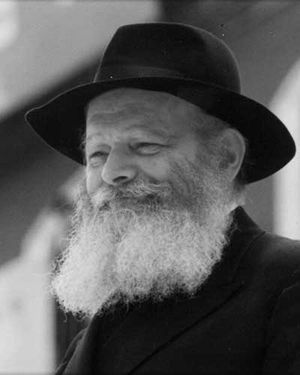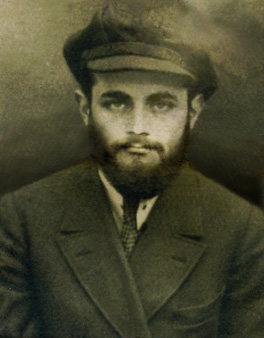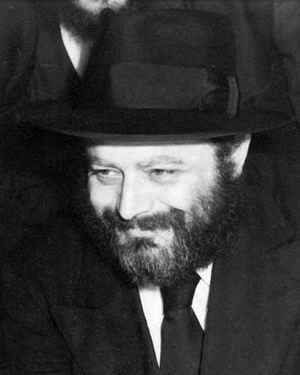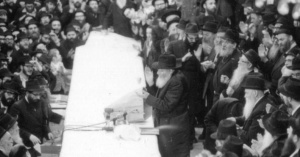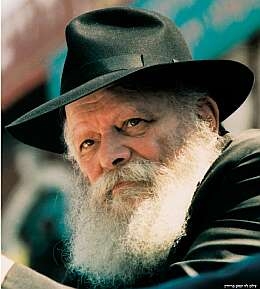Menachem Mendel Schneerson
Rabbi Menachem Mendel Schneerson (April 18, 1902 – June 12, 1994), referred to by his followers as The Rebbe, was a prominent Orthodox Jewish rabbi who was the seventh and last Rebbe (spiritual leader) of the Chabad Lubavitch branch of Hasidic Judaism (which is also part of Haredi Judaism.) He was fifth in a direct paternal line to the third Chabad Lubavitch Rebbe Rabbi Menachem Mendel Schneersohn (known as the Tzemach Tzedek), his namesake.
In 1950, upon the death of his predecessor, father-in-law, and cousin Rabbi Joseph Isaac Schneersohn (Yosef Yitzchok Schneersohn), known as the "Previous Rebbe" or Rebbe Rayat"z (an acronym of his name), Menachem Mendel assumed the leadership of the Chabad branch of Chasidic Judaism. He was to lead the movement until his passing in 1994, greatly expanding its worldwide activities and founding a network of institutions of Jewish study and Torah outreach. He raised the issue of Jewish Messianship to the forefront of the Jewish world, and was hailed by a majority of Lubavitchers during his lifetime as the long awaited Mashiach, or Jewish Messiah. He had no children, but his legacy remains with over 2600 institutions he initiated throughout his lifetime.
Contents
Biography
Early life
Born in Nikolaiev, Ukraine, Schneerson received mostly private education. He had two younger brothers, Dovber and Yisroel Aryeh Leib. He was enrolled in the secular Yekaterinoslav University for part-time study of mathematics at the age of 16. His father, Rabbi Levi Yitzchak Schneerson, a renowned kabbalist who served as the Chief Rabbi of Yekaterinoslav (Dnepropetrovsk) from 1907-1939, was his primary teacher. He intensively studied Talmud and rabbinic literature, as well as the hasidic view of Jewish mysticism and Kabbalah. He received his Rabbinical ordination from Rabbi Yosef Rosen (the Rogatchover Gaon). He became engaged to Chaya Mushka Schneerson in Riga in 1923 and married her five years later in 1928 after being away in Berlin. During those two years in Berlin his landlord was his distant secular cousin, Dr. Michael Wilensky. He returned to Warsaw for his wedding and in the announcement of his marriage in a Warsaw newspaper in 1928 he was attributed "a number of academic degrees". Following the marriage they went to live in Berlin, Germany, to study mathematics and philosophy at one of its universities. According to Laufer, Rabbi Joseph Dov Soloveitchik of Boston was also studying at the university in Berlin at the time, and he lived nearby. "Whenever he had a question about an academic or religious text, he would stop over at Schneerson's house and consult with him." In a hagiographic biography, Laufer, citing a Rabbi who heard from Soloveichik himself and a Kfar Chabad Rabbi who heard it from associates of Soloveichik, says that "even though Schneerson did not spend much time at his studies, his marks were always higher than Soloveichik's". Moreover, "the Rebbe was known to have received several advanced degrees in Berlin, and then later in Paris." Another witness in Laufers book, a resident of Tel Aviv, claimed that everyone knew the Rebbe was attending university, and that despite his low-key presence, "everyone knew that a unique personality was in town." Professor Menachem Friedman on a trip to Berlin 70 years later, was only able to find records of classes taken for one and a half semesters; his attendance was recorded at the University of Berlin in a "record of the students who audited courses at the university without receiving academic credit." However, he was unable to find any records for the other 6 years that Schneerson was in Berlin.
According to Lubavitch hagiographies, quoting eyewitnesses during his time in Berlin, he forged friendships with two other young rabbis studying in Berlin: Joseph Soloveitchik and Yitzchok Hutner. However, Soloveitchik's son has denied that they knew each other in Berlin, the validity of this source is disputed.
In 1931 Schneerson's younger brother, Yisroel Aryeh Leib, joined him in Berlin. He arrived and was cared for by the family as he was seriously ill with typhoid fever. He soon changed his name to Mark Gurari and attended classes at the University of Berlin from 1931 to 1933. In 1933, Schneerson helped Gurari escape from Berlin, but with Gurari's increasing secularism and his relationship with Regina Milgram, a secular woman, the brothers grew apart. Gurari escaped to Mandate Palestine in 1939 with Milgram where they married. (ISBN 0964724308) Vol. II, p.134, quoted: [1])
France
In 1933 Schneerson moved to France. According to hagiographies authorized by Lubavitch and eyewitness reports, he attended classes at the Sorbonne in Paris. Israeli anthropologist Menachem Friedman, in a visit to France in 1996 was unable to find any documentation from the Sorbonne records, but found that from 1935 to 1938 he was studying at the École spéciale des travaux publics, du bâtiment et de l'industrie (ESTP), a Technical College in the Montparnasse district. He completed a diploma in electrical engineering , and received a licence to practice. [2] He lived for most of his time in Paris at 9 Rue de Boulard in the cosmopolitan 14th arrondissement in the same building as his brother-in-law Mendel Hornstein [3]. They also studied together at ESTP, but Hornstein failed the final exams. He was not able to escape and ultimatly perished in Treblinka. [4]
Schneerson learned to speak French which he put to use in establishing his movement there after the war. The Chabad movement in France was later to attract many Jewish immigrants from Algeria, Morocco, and Tunisia.
America and leadership
In 1941 Schneerson escaped from France on the Serpa Pinto, which was the last boat to cross the Atlantic ocean before the U-boat blockade began, and joined his father-in-law Rabbi Joseph Isaac Schneersohn in the Crown Heights section of Brooklyn, New York. He spent some time working in the Brooklyn Navy Yard. In 1942, his father-in-law appointed him director of the movement's central organizations, placing him at the helm of a budding Jewish educational and hasidic outreach empire across the United States, Canada, Israel, and North Africa.
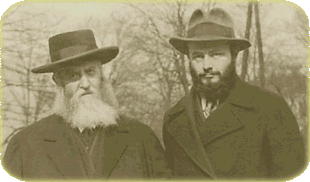
His father-in-law died in 1950. His followers immediately began pressuring Schneerson, then known as the Rama"sh (an acronym of his name) to succeed his father-in-law. At first he steadfastly refused, saying that his father-in-law "lived on". In that "vacuum", another candidate for leadership emerged: Rabbi Shemaryahu Gurary, Joseph Isaac Schneersohn's elder son-in-law, married to his elder daughter. Gurary, known as the Rasha"g, failed to capture support among the Hasidim, who continued pressuring Schneerson to relent and accept the position of "Rebbe". On the first anniversary of his father-in-law's passing, he finally relented, with the encouragement of his wife, and became The Rebbe.
Gurary became a devoted follower; however, his son Barry Gurary resented what he perceived as Schneerson's "usurpation" of what he thought should have been his father's position. Various intra-family disputes arose. For example, when invaluable books and manuscripts from the Chabad library began to go missing, Schneerson's wife, Chaya Mushka, suspected her nephew Barry and ordered a surveillance camera installed, which then confirmed her suspicions. This led to a protracted battle in Federal Court over the library's ownership. Barry Gurary claimed that the library was a family heirloom and as the previous Rebbe's sole grandson, he claimed ownership of it. Schneerson countered that the library was the collective property of the Chabad movement. Barry's mother, Hanna, sided with him, while his father remained staunchly devoted to Schneerson, leading to a deep rift in the Gurary family. On the fifth day of the Hebrew month of Tevet, the court handed down its decision--an overwhelming victory for Schneerson. His followers commemorate this day each year as Didan Notzach ("We did triumph") a kind of "V-Day".
Schneerson undertook to intensify the outreach program of the movement, bringing in new followers from all walks of life, and aggressively sought the expansion of the baal teshuva movement. His two most famous outside of Chabad early shluchim (emissaries) were Rabbi Shlomo Carlebach and Rabbi Zalman Schachter-Shalomi, with tens of thousands more within Chabad.
Other Orthodox Jews were bothered by the fact that Lubavitch outreach efforts extended to them as well as to non-affiliated Jews. The Satmar sect attacked him for not sufficiently opposing Zionism, a philosophy considered heretical by that group. The proximity of Crown Heights to Satmar enclaves in Williamsburg, Brooklyn, and the "conversion" of some prominent Satmar Hasidim to Chabad caused friction, culminating in an incident one year in which a group of Lubavitchers walking through the Satmar enclave in Williamsburg on their way to visit a synagogue to spread Schneerson's message were set upon and beaten by a mob. Nonetheless, Schneerson and Rabbi Joel Teitelbaum, the Satmar Rebbe, held each other in high esteem.
Vision
Part of Schneerson's vision was the training of thousands of young Chabad rabbis and their wives, who were sent all over the world by him as shluchim (Hebrew: "emissaries") to further Jewish observance.
He oversaw the building of schools, community centers, youth camps, college campus centers (known as "Chabad houses"), and reached out to the most powerful Jewish lay leaders and non-Jewish government leaders wherever they found themselves. The United States Congress and President issue annual proclamations declaring that the Rebbe's birthday, usually a day in March or April that coincides with his Hebrew calendar birth-date of 11 Nisan (a Hebrew month), be observed as Education and Sharing Day in the United States and a few other countries around the world.
Schneerson instituted a system of "mitzvah campaigns" called mivtzoim; these encouraged Jews to increase their level of Jewish religious practise. They commonly centred on issues such as keeping kosher, lighting Shabbat candles, studying Torah, the laying of tefillin, helping write Torah scrolls and teaching women to observe the niddah laws of Jewish family purity (laws pertaining to menstruation and ritual immersion afterwards in a pool of water known as a mikveh). Lubavitchers went to street-corners, and rode in "Mitzvah tanks", mobile outreach centers, encouraging Jews to increase their religious observance. He also launched a campaign to promote observance of the Noahide Laws among gentiles.
Schneerson's activities spread to many far flung areas of the Jewish world. Since the time of the Rebbe Sholom Dovber Schneersohn, Chabad had been involved with the Sephardic world. Schneerson was revered by Rabbis Israel Abuhatzeira (known as Babba Sali), Meir Abuhatzeira, Yitzchak Kadouri and Mordechai Eliyahu (a former Chief Rabbi of Israel). The latter two often visited him in Brooklyn, while the others maintained a correspondence with him. In the late 1970s, Schneerson joined with other organizations to orchestrate an exodus of Jews from countries such as Iran, laying the framework for Sephardic Hasidim. There are currently several Sephardic Chabad congregations.
Scientists who called on him, such as Herman Branover, professor of physics at Ben-Gurion University in Beer-Sheva, Israel, noted that he had a keen understanding of scientific issues. Branover himself, a Russian-Israeli authority on solar energy, is an active member of the Lubavitch movement. He frequently turned to Schneerson for advice on his scientific research. According to the millionaire mining magnate Joseph Gutnick of Australia, it was Schneerson who pointed out to him the precise geological points on a map of Australia to commence mining for gold. He was also given guidelines in his search for diamonds. Gutnick was subsequently appointed by Schneerson as his main representative to the Israeli government, and was instrumental in the election of Benjamin Netanyahu as prime minister of Israel in 1996.
Schneerson rarely chose to involve himself with questions of halakha (Jewish law). Some notable exception were with regard to the use of electrical appliances on the Sabbath, sailing on Israeli boats staffed by Jews, and halakhic dilemmas created when crossing the International Date Line. Responsa literature on the subject reflect the great deference that prominent arbiters of halakha showed Schneerson.
He very rarely left Crown Heights in Brooklyn, except for frequent lengthy visits to his father-in-law's gravesite, the ohel ("tent"), in Queens, New York. Upon the death of his wife in 1988, he further secluded himself, first in his home on President Street and after the traditional year of Jewish mourning, moved into his study above the central Lubavitch synagogue at 770 Eastern Parkway, Brooklyn (commonly referred to as either "Lubavitch World Headquarters", or as "770").
It was from "770" that Schneerson directed his emissaries' work. He would hold court at all hours of the day and night, involving himself in every detail of his far-flung movements' developments, being known as a man who did not sleep much. People who had appointments with Schneerson were commonly summoned to see him at extremely late hours. The highlight of his public role would be displayed during special celebrations called farbrengens ("celebrations") on Sabbaths, holy days, and special days on the Chabad calendar when he would lead the packed hall with long talks called maamorim ("[scholarly] talks") or sichos ("[scholarly] discussions"), and with songs called nigunim, that would last all night. They would often be broadcast via satellite to Lubavitch branches all over the world.
Later life
In 1977 Schneerson suffered a massive heart attack while celebrating the hakafot ("circling" [in the synagogue]) ceremony on Shmini Atzeret. Nonetheless, he insisted on finishing the ceremony with the customary dancing. Despite the best efforts of his doctors to convince him to change his mind, Schneerson refused to be hospitalized. This necessitated building a mini-hospital in "770." Although he did not appear in public for several weeks, he continued to deliver talks and discourses from his study via intercom. On Rosh Chodesh Kislev, the first day of the Hebrew month of Kislev, he left his study for the first time in over a month to go home. His followers celebrate this day as a great holiday each year, for his miraculous recovery.
In 1983, on the occasion of his 80th birthday the U.S. Congress proclaimed Schneerson's birthday Education Day, USA, and awarded him the National Scroll of honor.
As the movement grew and more demands were placed on Schneerson's time he ended the practice of meeting followers individually in his office. In 1986 Schneerson replaced these personal meetings, known as Yechidut, with a weekly receiving line in Seven-seventy. Almost every Sunday thousands of people would line up to meet briefly with Schneerson and receive a dollar, which was to be donated to charity. People filing past Schneerson would often take this opportunity to ask him for advice or to request a blessing. This event is usually referred to as 'Sunday Dollars'.
Following the death of Schneerson's wife in 1988 he withdrew from some public functions and became generally more reclusive. In 1991, he stated that: "I have done everything I can do to bring Moshiach (the Jewish Messiah), now I am handing over to you (his followers) the keys to bring Moshiach." A final campaign was started to bring the messianic age through acts of "goodness and kindness" and his followers placed advertising in the mass media such as many full-page ads in the New York Times urging everyone to contribute toward the messiah's imminent arrival, by increasing in their good deeds.
In 1991, Schneerson faced an anti-Semitic riot in his neighborhood of Crown Heights which became known as the Crown Heights Riot of 1991. The riot began when a car accompanying his motorcade returning from one of his regular cemetery visits to his father-in-law's grave accidentally struck an African American child who subsequently died. In the rioting, an Australian Jewish graduate student was murdered, many Lubavitchers were badly beaten, and much property was destroyed.
In 1992 he was felled by a serious stroke while at the grave of his father-in-law. The stroke left him unable to speak and paralyzed on the right side of his body. Nonetheless, he continued to respond daily to thousands of queries and requests for blessings from around the world. His secretaries would read the letters to him and he would indicate his response with head and hand motions.
Despite his deteriorating health, Schneerson once again refused to leave "Seven-seventy" . Several months into his illness, a small room with tinted glass windows with an attached balcony was built overlooking the main synagogue. This allowed him to pray with his followers, beginning with the Rosh Hashana services and after services, to appear before them by either having the window opened or by being carried onto the balcony.
During these appearances his followers would chant the traditional salutation of a Rebbe and, generating some controversy, append to it the title of Moshiach: Yechi Adonenu Moreinu v'Rabbeinu Melech Hamoshiach l'olam voed! - "Long live our Master our Teacher and our Rabbi King Messiah forever and ever!"
When sung before him in his last months, Schneerson vigorously encouraged the singing by swaying to and fro and swinging his hand, as he had done during the singing of other songs at the numerous farbrengens over the years. From this and his previous public statements his followers "extrapolated" that he acceded to their wish that he be the "Messiah". He passed away unable to verbalize and say anything to confirm his followers' longed-for dream that he be the actual long-promised Jewish Messiah. However, many believe that he continues to be the Messiah, and that he will lead the Jewish people to redemption, though this matter (despite some halachic supports [5]) is controversial.
Some contend that most Chabad Chassidim believe that he is the Messiah, and that the controversy is truly about whether or not to publicize that fact -- but it is manifestly unclear how large that percentage is [6]. For more information on this controversy, see the article on Lubavitch.
After his death, a bill was introduced in the U.S. House of Representatives by Congressmen Charles Schumer, John Lewis, Newt Gingrich, and Jerry Lewis to bestow on Schneerson the Congressional Gold Medal. On November 2, 1994, the bill passed both Houses by unanimous consent, honoring Schneerson for his "outstanding and lasting contributions toward improvements in world education, morality, and acts of charity".
US President Bill Clinton spoke these words at the Congressional Gold Medal ceremony "The late Rebbe's eminence as a moral leader for our country was recognized by every president since Richard Nixon. For over two decades the Rabbi's movement now has some 2000 institutions; educational, social, medical, all across the globe. We, (The United States Government) recognize the profound role that Rabbi Schneerson had in the expansion of those institutions."
Succession
Chabad Hasidim believe that there is no successor to Schneerson, and that he is in that sense still their leader. Many believe that he will return as the Messiah; this view has led to controversy with other Orthodox groups. Many, quoting Talmudic passages such as Ya'akov avinu lo meis ("our forefather Jacob did not die") (Talmud Ta'anit 5b), and statements that the Rebbe himself made, insist he has not died at all, and refuse to put the typical honorifics that Jews normally use for the dead (e.g. zt"l or Zecher Tzaddik Livrocho, "may the memory of the righteous be for a blessing") after his name. All, however, still consider him to be the Lubavitcher Rebbe.
Based on the terms of Schneerson's will Rabbi Yehuda Krinsky now serves as chairman of the Chabad-Lubavitch Merkos L'Inyonei Chinuch education establishment, the Kehot Publication Society, and the Machne Israel fundraising organization for Chabad's congregational work. Rabbi Avrohom Y. Shemtov now serves as chairman of the Executive Committee of Agudas Chasidei Chabad. This has been the subject of a long dispute among other members of the movement since the will only made Krinsky executor of Schneerson's personal property. (In a letter from the beth Din of crown heights dated 17 Iyar 5755 (1995)).
Many Chabad Hasidim practice a custom of attempting to communicate with him through his writings. In this view, the late rebbe is held to guide the questioner to open a book to a specific page, in order to communicate a message from beyond this world. While there are a small number of references in Jewish tradition for opening books of the Tanach on random pages in order to receive divine inspiration (most notably the Vilna Gaon's method), the practice of opening books of a deceased Rebbe's writings in order to receive communication from him appears unique to Chabad. This practice is by no means universal within Chabad, with many people simply not practicing it and some even opposed to it. The Rebbe himself said of his father-in-law (which is interpreted to refer to the Rebbe himself as well) , after his passing, that 'he will find a way of answering'.
Political activities
United States
Both Democrats and Republicans politicians sought his support. Generally, Lubavitch tends to support more conservative politicians such as those who back school prayer, are anti-abortion, pro-Israel, and are generally supportive of Bible values, about which Schneerson was publicly vocal. Aspirants for the job of mayor, governor, congressman, senator, in the states of New York and New Jersey would come calling and have their pictures with the rebbe published in newspapers with large Jewish readerships and voters.
Schneerson predicted, paid close attention to, and rejoiced in, the fall of communism in Eastern Europe starting in 1989. Under the Bolsheviks his father-in-law had been imprisoned and tortured and had his massive collection of writings confiscated, and the movement banned on pain of exile to Siberia. So too his father Rabbi Levi Yitzchock Schneerson was imprisoned and sent to live in exile in Alma Ata, Kazakhstan. His father was never freed and died in Alma Ata. Throughout the years of Communist repression of religion, Schneerson maintained intensive contacts with an underground network of his followers in the Soviet Union. Once the Iron Curtain fell, he quickly sent hundreds of new emissaries, known as shluchim, to the former Soviet Union. During the Desert Storm war against Iraq in 1990-1991, messianic fever ran high as Schneerson interpreted events in the light of Torah and midrash, declaring that: "Moshiach is already here, all we need to do is to open our eyes to see him."
Israel
Schneerson never visited the State of Israel, where he had many admirers and critics. He held a view similar to Rabbi Joseph Soloveitchik, that according to Jewish law, it was uncertain if a Jewish person who was in the land of Israel was allowed to leave. One of Israel's presidents, Zalman Shazar, was a religiously observant person of Lubavitch ancestry and his visits to Schneerson were reunions of sorts. Prime Minister Menachem Begin and later Benjamin Netanyahu also paid visits and sought advice. In the elections that brought Yitzhak Shamir to power, Schneerson publicly cajoled his followers and the Orthodox members in the Knesset to vote against the Labor alignment, the only time that he took a public political stance, leading to articles in Time and Newsweek and many newspapers and TV programs.
During the Six Day War in 1967 and the Yom Kippur War of 1973, he called in public for the Israel Defence Forces to capture Damascus in Syria and Cairo in Egypt. He was vehemently opposed to any withdrawals by Israel's armies from captured territories, and was against any concessions to the Palestinians. He lobbied Israeli politicians to legislate on Who is a Jew to declare that "only one who is born of a Jewish mother or converted according to halakha (Jewish biblical religious law) is Jewish". This caused a furor in the United States where some Jewish philanthropies cut off their financial support of Lubavitch since most of their members were connected with Reform and Conservative Judaism.
Responsa by Schneerson
Schneerson is known for authoring a voluminous collection of responsa. It encompasses a wide array of pertinent topics. He addresses several modern issues, such as matters pertaining to outer space, fossilization, science, human behaviour, anatomy, geology, psychiatry, cosmetology, Torah subjects, Jewish holidays and Jewish education.
The majority of his responsa is printed in Igrot Kodesh (Hebrew and Yiddish) and Letters from the Rebbe (English).
Books by Schneerson
- The reader should note this list is incomplete
- Likkutei Sichot - 39 volume set of the Schneerson's talks on the Torah portions, Jewish Holidays, and other issues. (16,867pp)
- Igrot Kodesh - 36 volume set of Schneerson's Hebrew and Yiddish letters. (11,948pp)
- Hayom Yom - An anthology of Chabad aphorisms and customs arranged according to the days of the year.
- Haggadah Im Likkutei Taamim Uminhagim - The Haggadah with a commentary written by Schneerson.
- Reshimot - 7 volume set of Schneerson's writings discovered after his death. (2,190pp)
- Hadran al HaRambam - Commentary written by Schneerson on Mishneh Torah.
- Sefer Hasichot - 10 volume set of the Schneerson's talks from 1987-1992. (4,136pp)
- Sefer Hashlichut - 2 volume set of Schneerson's advice and guidelines to the shluchim he sent.
- Torat Menachem - 30 volume set of Maamarim and Sichos from 1950-1959. (Based on participants' recollections and notes, not proofread by Schneerson).
- Torat Menachem Hisvaaduyot - 43 volume set of Maamarim and Sichos from 1982-1992. (Based on participants' recollections and notes, not proofread by Schneerson).
- Letters from the Rebbe - 5 volume set of Schneerson's English letters.
Rebbes of Lubavitch
- Shneur Zalman of Liadi (1745-1812)
- Dovber Schneuri (1773-1827)
- Menachem Mendel Schneersohn (1789-1866)
- Shmuel Schneersohn (1834-1882)
- Sholom Dovber Schneersohn (1860-1920)
- Joseph Isaac Schneersohn (1880-1950)
- Menachem Mendel Schneerson (1902-1994)
Time-line of Lubavitcher rebbes
Template:Start box Template:Succession box Template:End box
See also
External links
The Ohel
Writings available online
- Chabad.org - Literature
- Sichos Kodesh - The Rebbe's original unedited talks 1950 - 1981(in Yiddish)
- Sichos B'Laha"k - The Rebbe's unedited talks (in Hebrew)
- Sichos in English
- Igros Kodesh in Hebrew
- Toras Menachem in Hebrew
- Hayom Yom in Hebrew
Biography
Historical sites
- Proclamation of Education and Sharing Day 2002 by President George W.Bush also honoring the 100th birthdate of Rabbi Schneerson
- Education and Sharing Day, U.S.A., 2006
- Numerous proclamations by President Reagan citing work of Rabbi Schneerson and promotion of the Seven Noahide Laws
- Congressional Gold Medal Recipient Rabbi Menachem Mendel Schneerson
- Tributes to the Lubavitcher Rebbe by Menachem Begin, Bill Clinton, Newt Gingrich, Israel Meir Lau, John Lewis, Joseph Lieberman, Yitzhak Rabin, Aviezer Ravitzky, Jonathan Sacks, Lawrence Schiffman, Adin Steinsaltz, Margaret Thatcher, Elie Wiesel and Elliot Wolfson.
- Family Tree
- Rabbi Dr. Tzvi Hersh Weinreb of the Orthodox Union Commemorative remarks upon the occasion of the 10th Yahrzeit of the Lubavitcher Rebbe
